The state capital of Rajasthan, Jaipur lies on the edge of the Thar Desert, surrounded by the Aravali hills. One of the earliest planned cities in India, Jaipur was founded in 1727 by Sawai Jai Singh II of the ruling Rajput dynasty as his new capital. Its remarkably well-preserved heritage - which includes hilltop forts, bustling old markets, and lovely palaces - has made it a part of the golden triangle of Indian tourism.
Summers are very hot in Jaipur, with temperature almost 45°C while the winters are cool and ideal to plan for a holiday, although the temperature may dip down to 8.3°C in winter.
Jaipur is well connected by Air , Rail line & Road with major cities.
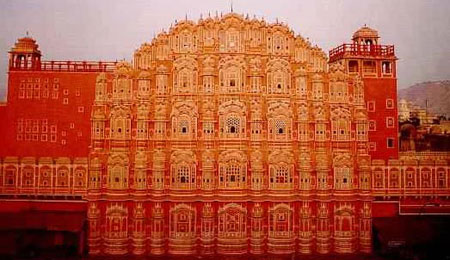
Hawa Mahal, or the Palace of Winds, built by Maharaja Pratap Singh, is located on the southern part of Jaipur. This beautiful five-storeyed building, designed to replicate the crown of Lord Krishna, looks like a honeycomb having about 1,000 small windows. These have latticework that encouraged cool air or doctor breeze to enter the palace, air-conditioning the whole area during the summers. The pink and red sandstone on the exterior gives it a magnificent look in the morning. The palace is part of the royal City Palace extending till the Zenana or the chambers of women.
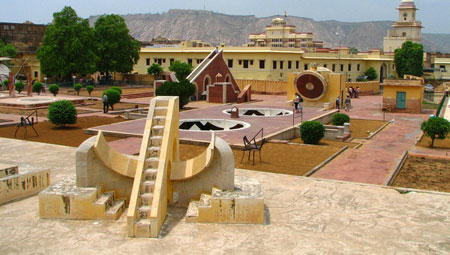
Built by Maharaja Jai Singh, this observatory, officially declared as the national monument, has a huge collection of astronomical instruments. Beautifully crafted in marble and local stone, it is one of the largest buildings in the country that is dedicated to the exploration of celestial bodies. It consists of around 14 fixed and focused devices that measure time, predict eclipses, track stars, and locate earth orbits around the sun.
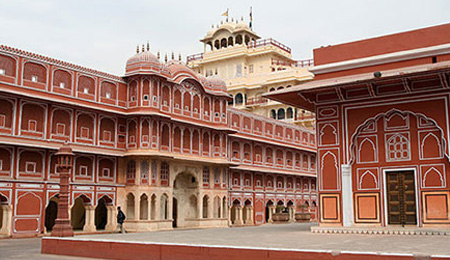
This gigantic fort includes two more forts inside, and is located on the north-east part of Jaipur. City Palace was the seat of the kings. It has a huge array of buildings, courtyards, temples and gardens. Its construction was started by Jai Singh following a perfect blend of Indian and European styles of architecture. The magnificent grid pattern encloses Mubarak Mahal, Chandra Mahal, Mukut Mahal, Palace of Maharani, Govind Temple and City Palace Museum. Chandra Mahal, one of the inner forts of City Palace, has a museum of its own and is still a residence of the royal family members.
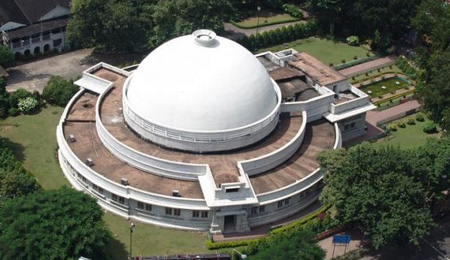
It offers unique audio-visual education about stars and entertainment with its modern computerised projection system. Entry fee As. 20.00 show timings: 11.00, 13.00, 15.00, 17.00, 18.00, 19.00 hrs. Phone: 2381594
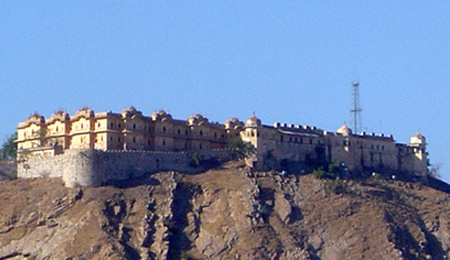
Standing on the edge of the hills of Aravalli, the Nahargarh Fort gives a mesmerizing view of the pink city of Jaipur. Nahargarh literally means "abode of tigers", evoking the royal legacy of Rajasthan. Maharaja Sawai Jai Singh, who founded Jaipur, built this fort. The fort has been part of important historical events: treaties of the Marathas were signed here, and it was the refuge of British women during the Sepoy Mutiny. The fort served as a hunting residence for the kings. The rooms of this beautiful fort are linked with long corridors.
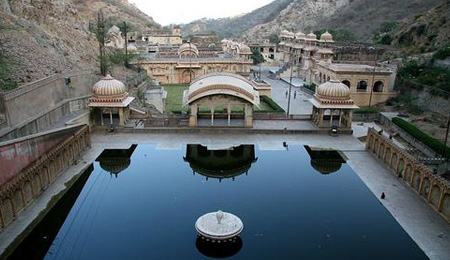
In the vicinity of the city, 10 kms. from Jaipur, Galta is situated amidst the range of hills east of the city. On the top of the hill. overlooking the Galta valler is a sun temple. To the east of the temple is a reservoir or a tank which is fed by spring of pure water falling from a Gaumukh or an outlet shaped like the mouth of a cow. On way to Galta, by the Ghat-ki-Guni, is a range of hills crowned with the fort of Amargarh.
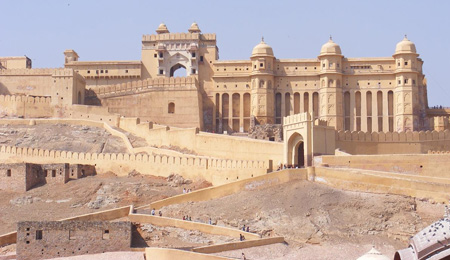
Located at a distance of around 11 km from Jaipur, Rajasthan , the Amber Fort stands perched atop a cliff beside the Jaipur Delhi Highway. The architecture is a fine blend of the Mughal and Rajput schools of architecture, beautifully combining white marble and redstone. The beautiful Maota Lake lends the majestic structure a splendid view. The sturdy ramparts and the lovely palaces make Amber Fort Jaipur one of the prime attractions of the state.
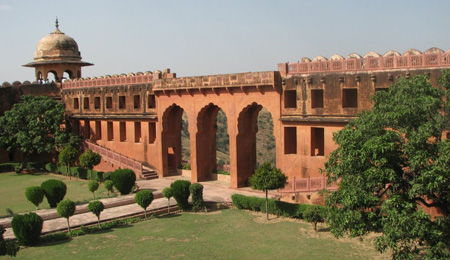
This beautiful creation by Maharaja Jai Singh, located at Amber, Jaipur stands on the Cheel Ka Teela (Hill of Eagles), a promontory of the Aravalli Hills. Located 400 metres above and similar in structure with the famous Amber Fort, it was meant to protect the latter. One can reach the Amber Fort through the secret subterranean passage from Jaigarh Fort. This fort is 3 km long and 1 km wide. It has the world's largest cannon on wheels, called Jaivana; a few palace complexes which served as the residences of the royal families; a well maintained garden; and a museum.
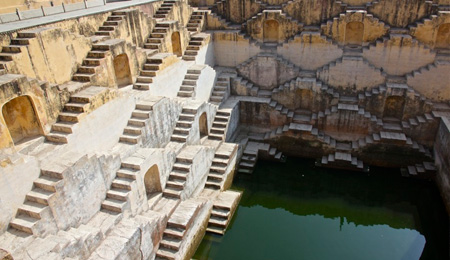
It was a water preserve pool of previous time. It’s an eight story staircase pool and looks very nice very excellent view of amber palace, amber fort and mountains and ramparts on mountains. This place reflects the real blend of nature and religion that make it a big tourist hub. Panna Meena ka Kund is situated in amber, Rajasthan and is presently undertaking rehabilitation. It was made in seventeenth century, its structure as most buildings in this typology were a signal of liberality and compassion towards the people. According to the local inhabitants of the place, it is impractical for a person to use the similar stairs to get down and go upstairs. Means, a person cannot apply the same stairs twice. It is a big secrecy of the place and all the tourists visiting here attempt to do this. But the local people of the place can do this quite simply because they are ordinary to it. It has an amazing making with symmetrical stairs. Octagonal shaped pieces are situated in the core of kund and terrace on 2 floors. The zigzag and geometrical pattern of the stairs make the visitors astonish and they get pleasure from it very much.
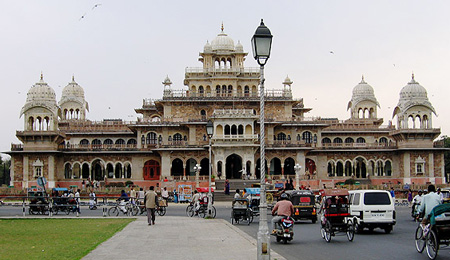
It is one of the oldest museums in Jaipur as well as in India, and was built by Sir Samuel Jacob in the 19th Century. It is known as the state's museum for Rajasthan and is also well known as the Government Central Museum. The beautiful building is located in the Ram Niwas garden, and stands as the epitome of the conglomeration of the Indo Saracen architecture. Here one can find a rich collection of numerous artifacts like carpets, paintings, stones, ivory, sculptures made up of metal, crystal works decorated with colours and every item that depicts the royal culture of Rajasthan.
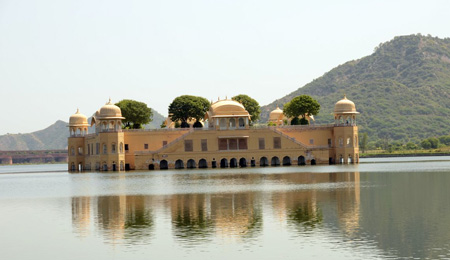
Literally translated to "Water Palace", this beautiful architecture is situated in the middle of a lake called the Sagar Lake, in the city of Jaipur. Both these were renovated as well as enlarged by King Jai Singh in the 18th century. The halls inside the palace at the first floor are well decorated, but cannot surpass the aromatic beauty of the Chameli Bagh upstairs. The area is surrounded by the Aravallis, other forts, temples, and mesmerizing natural beauty. The lake has well established drainage system, required depth for fishes to be alive, and five man-made islands for attracting migratory birds.
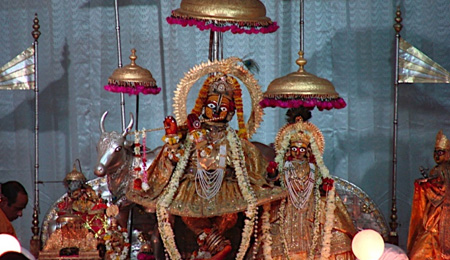
Govind Devji Templelies inside the City Palace. The Krishna deity, said to be the facial image of Lord Krishna, is originally from Vrindavan and was re-installed here by Jai Singh II. The Lakshmi Narayan Temple lies close to Moti Doongri Palace.
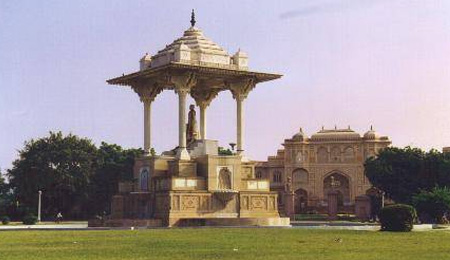
Rajasthan's most vibrant city, Jaipur, is enveloped in myriad colours. Known across the country for its sheer splendour and royalty, the Pink City's most famous landmark is the bustling Statue Circle. Located centrally, the busy spot may seem like an ordinary traffic intersection but is truly far from it. A popular hangout for locals and tourists, the Statue Circle surprisingly owes its name to its shape and not the grand Sawai Jai Singh statue it houses.